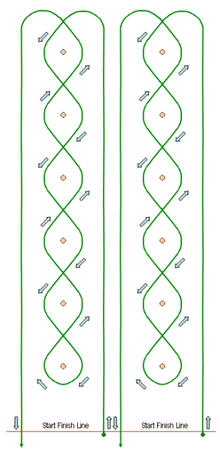Pole bending
 NHSRA pole bending | |
| Characteristics | |
|---|---|
| Mixed gender | Generally female, some males, particularly at youth levels |
| Type | |
| Equipment | Horse, horse tack |
| Venue | Indoor or outdoor riding arena |
| Presence | |
| Country or region | United States, Canada |

Pole bending is a timed event that features a horse and one mounted rider, running a weaving or serpentine path around six poles arranged in a line. This event is usually seen in high school rodeos and 4-H events as well as American Quarter Horse Association, Paint, and Appaloosa sanctioned shows as well as at many gymkhana or O-Mok-See events.
Setting up the pole bending pattern is crucial to the success of this event. The pole bending pattern is to be run around six poles. Each pole is to be 21 feet (6.4 meters) apart, and the first pole is to be 21 feet (6.4 meters) from the starting line. Poles shall be set on top of the ground, six feet (1.8 meters) in height, with no base more than 14 inches (35 cm) in diameter. These are the measurements implemented and endorsed by the National High School Rodeo Association. The purpose of a universal pattern is to be able to track and compare times everywhere poles are run.
Good horsemanship is the foundation for success in pole bending and barrel racing. The horse and rider team must work as one in order to excel. Various methods are implemented in pole bending from the “slalom” approach to the “side pass” approach. Depending on the horse/ rider combination, the rider needs to experiment to see what method works best for their application.
Each contestant will begin from a running start, and time shall begin and end as the horse’s nose crosses the line. A clearly visible starting line must be provided. An electric timer or at least two watches shall be used, with the time indicated by the electric timer or the average time of the watches used by official timers to be the official time.
A horse may start either to the right or to the left of the first pole and then run the remainder of the pattern accordingly. Knocking over a pole shall carry a five-second penalty. Failure to follow the course shall cause disqualification. A contestant may touch a pole with his or her hand in pole bending.
Poles shall be set on top of the ground, 6 feet in height, and mounted in bases with a 14 inch diameter. Poles shall be PVC pipe, and bases shall be rubber or plastic. For added safety, PVC caps are recommended. Preferred color for poles is natural white, but red, white, and blue rings shall be allowed. Solid rubber bases are preferred, but hollow plastic bases shall be allowed only if filled completely to emulate a solid base.
When riding a horse through the poles, the rider must first look to where they want to go. It is essential that the rider sits in the saddle and uses lower body and legs to navigate their horse through the poles. Forward motion must be maintained in order to keep all of the poles standing. The use of the horse’s hindquarters helps the horse zigzag through the poles in a smooth weave.
Anytime all of the poles are left standing is considered a good run, however; some of the fastest pole bending runs recorded have been those run at the National High School Finals Rodeo (NHSFR). The fastest time recorded in the pole bending event at the NHSRF was in 2009 when Emily Miller from Ingalls, Kansas recorded a 19.579 run.
Nez Perce Stake Race

The Nez Perce Stake Race is a type of pole bending race which is also a match race: two horses race on identical courses laid out side-by-side, with the loser eliminated and the winner moving up the brackets to race the other winners. It is not a timed event.[1] It is one of five game classes approved for horse club shows by the Appaloosa Horse Club (ApHC).[2] The ApHC rules state that racing competition is traditional to the Nez Perce Native American people.[1] However, it is unclear if this particular competition is derived from any traditional competition.
References
- 1 2 ApHC rulebook, rule 730, and "History", p. 11
- ↑ Application for Appaloosa Horse Club Show Approval Appaloosa Horse Club 2011. Accessed September 2011.
External links
- World Pole Bending Association Endorsement for pole bending events throughout the world. Home of the pole bending world finals.
- Runninghorses.net - Your Guide to All Things Fast - Barrel Racing & Speedhorse Online Community
- Pole Bending : Information, Photos, & Pattern From The Ultimate Horse Site
- Pole Bending Event Information From Pro Rodeo Online
- National High School Rodeo Association (2009). Retrieved from http://www.nhsra.com/index.php/2009-nhsfr-results/258-current-overall-standings
- National Pole Bending Association (2009). Retrieved from http://www.polebending.org.
- Smith, Ken. (2009, July 15). Ken and Pat Smith, Sunrise West Quarter Horses, LLC. Retrieved from http://www.sunrisewest.com/help.html